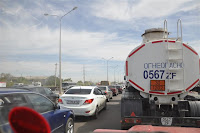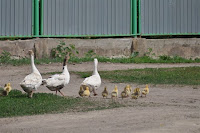 |
| Demoiselle Cranes are seen everyday on the Steppes |
 |
| Horse traffic jam |
 |
| There isstill plenty of soviet era monumental art in Kazakhstan |
 |
| A ploughed field campsite in eastern Kazakhstan |
 |
| Jackdaw mobs Black Kite |
 |
| We should get a signal here! |
 |
| Fake cut-out police car by road |
 |
| The road deteriorates again |
 |
| We have found that old quarries make ideal camp sites - they are usually secluded and little visited |
Our slow but enjoyable travel through Kazakhstan has made us realise that we are not going to be able to achieve our initial itinerary of visiting Almaty and Shimkent in the south and maybe even a day trip into Kyrgzstan (the land of few vowels). To do so would mean a bit of a rush all the way from Almaty to Ulanbattor in view of the way the visas work. We are now heading for the Russian border east of Semey and intent to travel through Russia to Irkutsch and Lake Baikal before entering Mongolia in the north east of that country. This was the original Plan A, so in some ways we are back on course. So we will see the highland Russian Altai region on our return through the border in western Mongolia.
 |
| Common Wheatear brings a grasshopper to its chicks |
 |
| Cowboy rounds up his horses |
 |
| Astana traffic jam | <><>
 |
| A handy vehicle inspestion ramp at a Kaz picnic stop |
 |
| Karlag memorials |
 |
| Entering Karaghandy |
 |
| Village scene |
Traffic Police We have seen cut out replicas of police cars and card board policemen to help with the war against driving transgressions. Police roadside checks are quite frequent and we have been pulled over a few times, mainly because the police are fascinated by our vehicle and caravan and want to have a closer look. This is usually done very amicably and ends in handshakes all round. Our most recent such event took a different turn, the police pulled us over and indicated that we did not have our headlights on - a crime on Kaz roads. It was a ‘fair cop’ as they say and mike was led off to the police car fearing the worst. On the spot fines are quite steep for this sort of offence and we were shown a price list indicating at 24000 tenge (about £100) fine for the offence. However the police used the fact that we had broken the law as an attempt to extort cash from us. Particularly dollars or Euros. The bribe they wanted was actually more than the fine which did not make sense. Anyhow Mike professed to have no dollars or Euros and asked if the police could write out the form and go through with the fine. The bribe came down to $20 very quickly and then the police gave up and could not be bothered to write out the fine form either so we walked free with our honour and wallet intact.
More on Road Casualty memorials As we mentioned in an earlier post, a feature on the road sides of Kazakhstan is the memorial stones, often with photo engravings or a ceramic photo, to the victims of fatal accidents. Sometimes these memorials are simple crosses or other insignia and at other times they are quite elaborate with carvings and fancy brickwork. Most seem to have iron fences round then (about 1-2 m square) we think mainly to stop cows and other domestic animals rubbing against them and breaking them. There seem to be an awful lot of road casualties in this part of the world. Sometimes several stones in one place. We have seen one of a family of five. On one stretch of 60 miles of more or less straight road we counted 34 memorials, those identifiably religious in nature were approximately half Moslem and half Christian. Of course not all fatal accidents are commemorated like this and we probably missed a lot. The sad thing was that so many of the pictures were of young men. Most memorials seemed to be on straight roads so it seems misjudged overtaking is the main problem.
Roadside Picnic stopsThe steppe roads in Kazakhstan have ‘picnic’ stops every few miles which are often badly littered and have toilets only for the desperate but they do have a feature which many of us would like to see at lay-bys in UK, namely a ramp you can drive onto so you can examine the underside of your vehicle and carry out maintenance work etc. This is very handy if, like us you need every few days to generally check that nothing underneath the vehicle is coming loose or getting dangerous, and more rarely to keep an eye on gearbox, transfer box and axle oil levels.. These sites are also good places to get rid of rubbish in the recepticals provided.
The Karlag memorialsJust south of Karamandy there is a field with several national memorials to the prisoners wo died as slave labourers in the Stalinist era camps clustered in the region, these were known collectively as the Karlag camps. The camps held two groups of prisoners. The first were prisoners of war captured on the German eastern front and elsewhere, including nationals of sympathetic countries. So in this category there were not only Germans, Italians, Japanese but also Romanians, Hungarians nationals and some French (possibly Vichy French?) and Koreans. The second group of prisoners were the victims of Stalin’s purges and internal transportations of undesirables. The memorials included ones from every new nation created on the breakup of the Society Union. These camps were active even for prisoners of war until the early 1950s. The rows of national monuments made for a very poiniant memorial on this barren moreland scene and both of us were quite moved.
Kindnesses from local people Whilst some people we have tried to communicate with have seemed to not want to try and understand our overwhelming experience has been one of people very much going out of their way to help us. We have already mentioned the people at the electricity office in Naurzum and the young student who translated for us - here are just a few more examples - when we asked a couple of young men where a shop was they took us there in their car; when we asked in a computer shop for something they didn’t have a member of staff took us to a shop which had; when we were having trouble meeting up with Mike’s contact Evgeny a driving instructor and his pupil interrupted their lesson to speak with him on the phone and guide him to us and the pupil also rang a friend who spoke some English and offered to find us an English speaking student to come and help us out; a young man in the shopping centre shut up his shop - twice - to help Mike find some gas and made phone calls on our behalf.
PS An update on the birds seen so far during the trip (to 31 May) and a list of all the waypoints of campsites etc will be posted on the file sharing site mentioned on the birds page.


